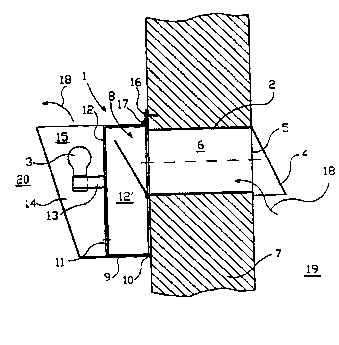Some of the information on this Web page has been provided by external sources. The Government of Canada is not responsible for the accuracy, reliability or currency of the information supplied by external sources. Users wishing to rely upon this information should consult directly with the source of the information. Content provided by external sources is not subject to official languages, privacy and accessibility requirements.
Any discrepancies in the text and image of the Claims and Abstract are due to differing posting times. Text of the Claims and Abstract are posted:
| (12) Patent Application: | (11) CA 2191727 |
|---|---|
| (54) English Title: | AIR VENT DEVICE INCLUDING A LIGHT DEVICE TO PREHEAT SUPPLY AIR |
| (54) French Title: | DISPOSITIF D'AERATION |
| Status: | Deemed Abandoned and Beyond the Period of Reinstatement - Pending Response to Notice of Disregarded Communication |
| (51) International Patent Classification (IPC): |
|
|---|---|
| (72) Inventors : |
|
| (73) Owners : |
|
| (71) Applicants : |
|
| (74) Agent: | NORTON ROSE FULBRIGHT CANADA LLP/S.E.N.C.R.L., S.R.L. |
| (74) Associate agent: | |
| (45) Issued: | |
| (86) PCT Filing Date: | 1995-05-31 |
| (87) Open to Public Inspection: | 1995-12-14 |
| Availability of licence: | N/A |
| Dedicated to the Public: | N/A |
| (25) Language of filing: | English |
| Patent Cooperation Treaty (PCT): | Yes |
|---|---|
| (86) PCT Filing Number: | PCT/NO1995/000087 |
| (87) International Publication Number: | WO 1995033959 |
| (85) National Entry: | 1996-11-29 |
| (30) Application Priority Data: | ||||||
|---|---|---|---|---|---|---|
|
A device for an air valve, particularly for use with a fresh air inlet through
a wall (7) in living rooms (20), and wherein the device (1) comprises a
receiver (9) preferably consisting of metal, plastic or another air-tight
material, and wherein the receiver (9) is adapted to be tightly attached to
the wall (7) around the internal valve opening (8), and wherein the receiver
(9) is divided into an outer room (12') and an inner room (15), a connection
(11) being established between the rooms (12', 15). To the receiver (9) is
attached a bulb holder (13) having a supply of electrical current for a bulb
(3), so that the fresh air stream flows past the bulb (3) and receives heat
therefrom before it leaves the receiver (9) and escapes into the living room
(20).
Dispositif pour clapet d'admission d'air particulièrement destiné à être utilisé avec une admission d'air neuf prévue dans un mur (7) de pièce d'habitation. Ledit dispositif (1) comporte un collecteur (9) de préférence en métal, plastique ou tout autre matériau étanche à l'air et conçu pour être fixé de manière hermétique sur le mur (7), autour de l'ouverture de la soupape interne (8). Ledit collecteur (9) est divisé en une chambre externe (12') et une chambre interne (15) reliées entre elles par un raccordement (11). Une douille d'ampoule (13) dotée d'une source d'alimentation électrique pour ampoule (3) est fixée au collecteur (9) de sorte que le flux d'air neuf s'écoule au-delà de l'ampoule (3) et bénéficie de la chaleur dégagée par cette dernière avant de sortir du collecteur (9) et de s'échapper dans la pièce d'habitation (20).
Note: Claims are shown in the official language in which they were submitted.
Note: Descriptions are shown in the official language in which they were submitted.

2024-08-01:As part of the Next Generation Patents (NGP) transition, the Canadian Patents Database (CPD) now contains a more detailed Event History, which replicates the Event Log of our new back-office solution.
Please note that "Inactive:" events refers to events no longer in use in our new back-office solution.
For a clearer understanding of the status of the application/patent presented on this page, the site Disclaimer , as well as the definitions for Patent , Event History , Maintenance Fee and Payment History should be consulted.
| Description | Date |
|---|---|
| Inactive: IPC expired | 2022-01-01 |
| Inactive: IPC from MCD | 2006-03-12 |
| Inactive: IPC from MCD | 2006-03-12 |
| Inactive: IPC from MCD | 2006-03-12 |
| Inactive: IPC from MCD | 2006-03-12 |
| Time Limit for Reversal Expired | 2003-06-02 |
| Application Not Reinstated by Deadline | 2003-06-02 |
| Deemed Abandoned - Failure to Respond to Maintenance Fee Notice | 2002-05-31 |
| Inactive: Abandon-RFE+Late fee unpaid-Correspondence sent | 2002-05-31 |
| Application Published (Open to Public Inspection) | 1995-12-14 |
| Abandonment Date | Reason | Reinstatement Date |
|---|---|---|
| 2002-05-31 |
The last payment was received on 2001-05-24
Note : If the full payment has not been received on or before the date indicated, a further fee may be required which may be one of the following
Please refer to the CIPO Patent Fees web page to see all current fee amounts.
| Fee Type | Anniversary Year | Due Date | Paid Date |
|---|---|---|---|
| MF (application, 3rd anniv.) - small | 03 | 1998-06-01 | 1998-05-20 |
| MF (application, 4th anniv.) - small | 04 | 1999-05-31 | 1999-05-25 |
| MF (application, 5th anniv.) - small | 05 | 2000-05-31 | 2000-04-18 |
| MF (application, 6th anniv.) - small | 06 | 2001-05-31 | 2001-05-24 |
Note: Records showing the ownership history in alphabetical order.
| Current Owners on Record |
|---|
| LEGABEAM NORGE AS |
| Past Owners on Record |
|---|
| OVE CHARLES VÝLSTAD |